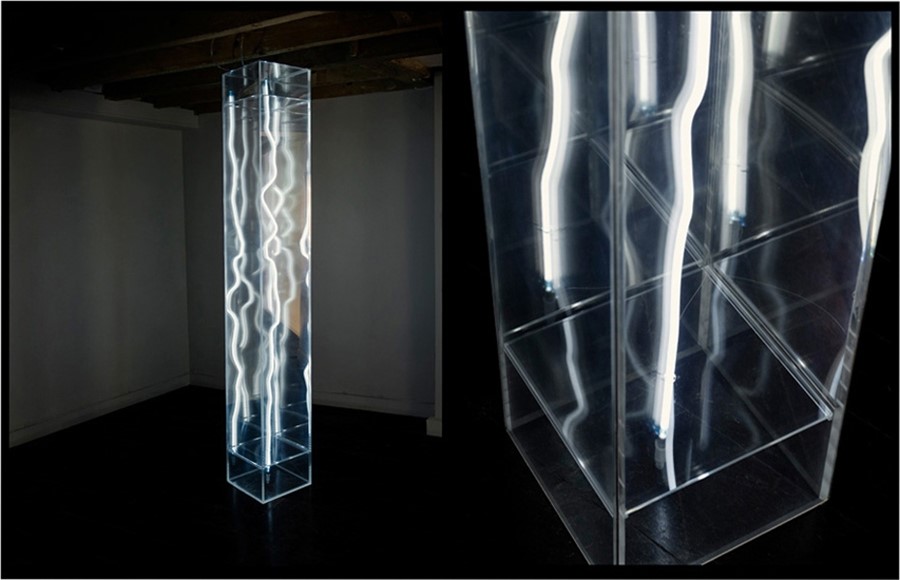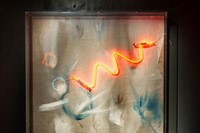Whether he is creating gargantuan lightning machines or the conditions that create tiny stars inside bell jars, the artist Paul Fryer has been postulating questions about cosmology, phenomenology and religion for over a decade with works that
Whether he is creating gargantuan lightning machines or the conditions that create tiny stars inside bell jars, the artist Paul Fryer has been postulating questions about cosmology, phenomenology and religion for over a decade with works that inspire wonder via the appropriation of cutting-edge science, and more pertinently electricity. His latest show The Electric Sky is no exception, exploring the controversial, but fast-growing theory that that the universe may be formed of a super-massive electrical grid, which would mean that lightning is beamed to us via plasma streams from a super-massive electrode we tend to commonly refer to as the sun. This would mean a lightning strike could be directly connected to other planets and, ultimately, other galaxies by an actual electrical circuit. These are genuinely radical ideas that have the potential to completely upset the view of reality being explored at CERN, but there are few artists better positioned to ponder such questions, given Fryer’s well-developed penchant for taking aim at sacred cows. Here, the artist tells AnOther why the theory of relativity might have no more validity as a concept than any other, and why you might be far more connected to a supernova than you ever dreamed possible.
Why the title The Electric Sky? What are you seeking to explore?
When Einstein postulated general relativity, he left out electro-magnetic force completely, and there’s a new theory about the plasma vision of the universe that makes me think what I’ve been thinking about might be more relevant than just my artistic curiosity. In this vision, instead of dark matter you have plasma, the super-excited state of gaseous matter – a super-heated gas stripped of electrons that can exist in a vacuum and conducts electricity. There are a growing number of people that think you can explain the mass of the universe by using a plasma model. Einstein was a very clever man – he invented, or rather discovered nuclear energy, something that became our touchstone in the 20th century. If he hadn’t done that he would just have been another scientist. And that’s the problem – people create or generate these sacred cows, and then no one’s allowed to question them. Huge industries build up around them and you end up with a science that’s not so much a science, it’s a dogma that can’t be challenged, and that’s quite scary. I’m an artist so I can think about these things and not be branded a crank, as a scientist talking about these things you can get into very deep water.
What would the plasma model mean in terms of how we currently understand the universe?
It would mean there would be no dark matter, there would be no black holes and that the sun isn’t a thermonuclear reaction, it’s a giant break-out point in space – it’s an anode with current flowing over the surface and that’s why it’s got a corona, because when you have high voltage in a vacuum, it creates a corona. Thermonuclear reactions don’t create a corona, as far as we know. If that’s the case, then a lot of physics, at the very least, might need modifying. It certainly means that things like CERN are in question and that the Big Bang model is in question. Obviously, it’s a very controversial theory and it’s one that I’m just thinking about. If it’s true, it means that all the stars in the universe are connected – literally connected – by a grid. Not by a star grid, but by an electric grid like the national grid that we have for power, a stellar one – a huge one – and it means that power flows between planets and stars all the time. It means that the lightning that we have on Earth comes from space, and that the sun is part of a huge network.
"When Einstein postulated general relativity, he left out electro-magnetic force completely, and there’s a new theory about the plasma vision of the universe that makes me think what I’ve been thinking about might be more relevant than just my artistic curiosity"
Why has this theory in particular fired your imagination?
It’s an amazing model of the universe because it’s so unified. Think of all the stars and galaxies connected electrically, it’s quite amazing. It means that comets are electrically charged bodies, so when they come into the sun they’re not balls of snow that are ablating in the heat or in the solar wind – they’re charged objects. They’re basically negatively charged, so when they come close to the anode of the sun they flare up. That’s why you get these enormous displays off of a comet. It means that there were probably some amazing things going on in the sky 2000 years ago that could’ve be explained electromagnetically, when man first conceived of God from the sky,
Is it your intention as an artist to create works that are a catalyst for more open-minded thought?
Well, I like to bring certain things to peoples attention but I’m an artist, so I try to make beautiful things as well. I suppose I like the idea of generating things that encourage meditation or thought in different areas. I think there’s an argument for saying that science and art, and even religion, are all just people thinking about things and coming up with ideas, but I don’t think you should take scientific theories literally any more than you should take The Bible seriously. Remember that the theories of yesterday are just that, and they become redundant.
Why are faith and science such constant sources of inspiration for you?
It’s because faith and science try and answer the same questions. In religion, you have people trying to figure the unknown and science tries to figure out the unknown too, or at least explain it. They’re just theories – the theory of general relativity, the theory of anthropogenic climate change – we should be allowed to question any of it because it’s all questionable, at the end of the day. In the show I have a representation of NGCC744. It’s a spiral galaxy that is a long way away – it would take us more than a thousand life times to get there – but it’s exactly the same as our spiral galaxy. It’s like a carbon copy of the Milky Way, which I find really freaky. I mean, I just read about it and flipped, so I did a piece of work about it because I imagined at that second somebody else doing exactly what I was doing in an infra-dimensional universe – whether it’s useful or not, I don’t know, but I find it significant.
How do all these questions about the universe tally with your personal notions of life and death?
I don’t know, but in the words of Phillip Larkin: we shall find out. I’m quite curious about death; I’m not scared. Not as scared as I was anyway. I think partly that comes from learning to die while you’re alive a little bit – learning from the things that happen to you so that you become less concerned about your ego. I think that’s very important. I think that people who do live completely through their ego and by their ego are in for a rude awakening. The longer you do that, the more you save it up. It’s like waiting for that first acid trip – people get terrified because they know that they have so much to lose, this huge elaborate house of cards they call a personality. I think the more open-minded you can train yourself to be in general, the better off you’re going to be.
The Electric Sky by Paul Fryer is currently showing at Pertwee Anderson Gold and runs until May 3.
Text by John-Paul Pryor



